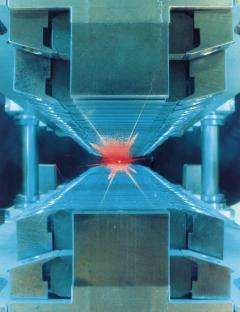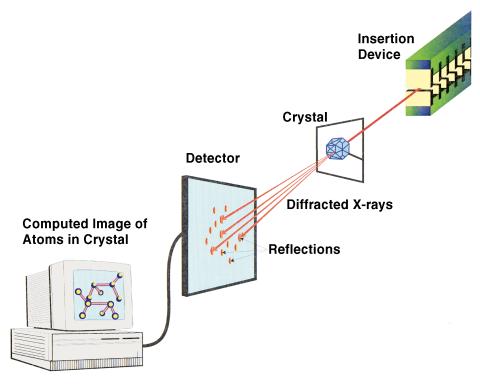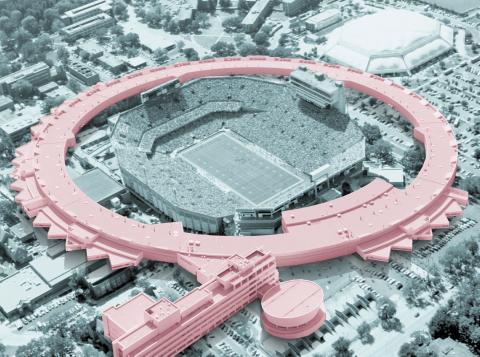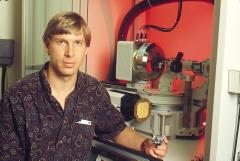
University of Florida chemistry Professor Randy Duran was like a professional sports photographer using a 19th-century Kodak Brownie to shoot a night game. The action was always just a dark blur in front of his camera.
``Imagine what Sports Illustrated covers would look like if their photographers didn't have fast, bright flashes,'' Duran says. ``They wouldn't be able to capture the receiver flying through the air to score the winning touchdown.''
So last May, Duran and his colleagues at the University of Florida and throughout the scientific community traded in their Brownies for a camera with the fastest, brightest flashbulb on the planet.
That flash is the Advanced Photon Source (APS), an $800 million facility at Argonne National Laboratory in Illinois that was dedicated May 1. The APS produces X-rays through a phenomenon called synchrotron radiation that are 10,000 times brighter than any previously available for research.
These X-rays will allow scientists in numerous disciplines to illuminate everything from chemical reactions to the molecular structure of DNA with stunning speed and clarity.
``Just like in photography, the better the lighting, the better and faster the exposures you can make,'' Duran says. ``The APS is the only place with X-rays fast enough and bright enough to do things like catch molecules in mid reaction.''
The APS represents a trillion-fold increase in power over the X-rays physicist Wilhelm Roentgen first discovered a century ago, Duran says, and will provide unprecedented views of the physical world, particularly in the materials and biological sciences.
The four to six weeks a year of ``beam time'' UF will get to conduct experiments at the APS is the equivalent of hundreds of years at older synchrotrons like the one at the Brookhaven National Laboratory on Long Island, New York.
``Things that took two to five hours to image at the Brookhaven
synchrotron will take less than a minute at APS,'' Duran says.

Birth Of An X-ray
Scientists in many fields quickly recognized the implications of Roentgen's 1895 discovery of X-rays, and have been searching in the 100 years since for ever-more-powerful X-ray beams with which to conduct their research.
Synchrotron radiation was actually considered a nuisance by the physicists who stumbled onto it in the 1960s while they were smashing atoms to study the building blocks of matter.
The physicists wanted the charged electrons they were accelerating to have as much energy as possible when they collided with each other, but the particles kept on throwing off energy in the form of radiation.
 |
| The cone of X-rays generated by positrons moves with near-speed-of-light energy through an insertion device. The array of permanent magnets produces a magnetic field that alternates up and down along the positron path, causing the particles to bend back and forth. At each bend, the positrons emit synchrotron radiation in the X-ray part of the spectrum. |
What was a problem for physicists was a boon to materials scientists and molecular biologists, who suddenly had a new source of powerful X-rays.
The original synchrotrons built to produce X-rays had very small ``experimental hutches,'' as in rabbit hutches, where scientists could perform only the most basic research on idealized small samples.
``It was kind of like how experiments are done on the space shuttle today,'' Duran says.
At the APS, experimental hutches measuring 13 by 42 feet will allow researchers to image samples as small as one-thousandth of an inch within a much larger ``real world'' context, such as inside a piece of operating industrial machinery.
``For example, the hutches at the APS are large enough to image what is happening to cross sections of individual fibers running through a carpet milling machine,'' Duran says.
The X-rays are born at a 750,000-volt electron gun, a cathode-ray tube much like the one in a television, that generates electrons and shoots them at a tungsten wafer that converts them into electron-positron pairs.
A series of linear accelerators raises the energy of the positrons to 7 billion electron volts, nearly the speed of light, before they are injected into the 1,104-meter-in-circumference storage ring inside the experiment hall.
Like race cars speeding around an oval track, a beam of positrons speeds around the storage ring 271,000 times per second. More than 1,500 magnets and a near-complete vacuum of less than one part per trillion keep the beam circling the ring without bumping into walls or any other gas molecules that would destroy the positrons.
Just as race cars give off energy in the form of heat and sound as they round a track's curves, positrons give off energy in the form of X-rays, ultraviolet, infrared and visible light as they circle the storage ring.
The storage ring and surrounding experiment hall are divided into 35 sectors, each with two beamlines extending tangentially from the storage ring enclosure into the experiment hall. One beamline originates at a bending magnet that steers raw radiation produced by the positrons. The other beamline originates at an array of magnets called an undulator that further enhances the brilliance of the X-rays.
The magnets in the undulator cause the positrons to wiggle as they pass through, increasing the amount of radiation they give off, much like speed bumps on a race track would increase the amount of heat and noise a race car gives off.
X-rays hotter than the surface of the Sun travel 80 meters down the beamline
toward the experimental hutch, being further focused with liquid
nitrogen-cooled mirrors and other optics until they arrive at the experimental
sample with an accuracy equal to 100th the width of a human hair.
 |
| In X-ray scattering experiments, an X-ray beam is passed through a sample and the intensities and directions of the scattered X-rays are measured. The pattern of scattered X-rays is converted by computer into information about the arrangements of atoms in the sample. |
Collaborating For Success
While the Department of Energy paid the $800 million cost of constructing the main synchrotron facility, applying the X-rays it creates to a host of scientific questions is the responsibility of the Collaborative Access Teams (CAT).
Hundreds of researchers from universities, industry and public and private research laboratories sought the opportunity to conduct experiments at the APS as part of a collaborative access team. After a rigorous selection process, 15 CATs --- representing 36 companies, more than 100 universities and 27 research institutes --- were chosen to build beamlines.
UF is a participant in the Materials Research Collaborative Access Team, also known as MRCAT. The team also includes the University of Notre Dame, Northwestern University and the Illinois Institute of Technology, Amoco Research and the divisions of Chemical Technology and Environmental Research at Argonne.
``Thanks to this new facility, we can expect advances in the areas of medicine, biotechnology and materials --- creating America's jobs, products and industries of the future,'' President Bill Clinton said in remarks for the APS dedication. ``The Advanced Photon Source demonstrates the successful partnership of private companies, the research community, and federal and state governments to help create that future.''
Each sector is designed, constructed and operated by a CAT with different specialized equipment.
``It's kind of like leasing a new store in a shopping mall,'' Duran says. ``The overall building is provided as a facility, but each store inside is constructed quite differently.''
The cost of constructing fully operational sectors with well-equipped beamlines is about $10 million. UF and Notre Dame each committed $625,000 toward construction of the beamline, with the Illinois Institute of Technology committing another $500,000 and Northwestern committing about $250,000. Amoco Research and the divisions of Chemical Technology and Environmental Research at Argonne committed a total of $3.6 million more, and the federal government will contribute another $4.4 million.
``The strength of this consortium lies in the fact that its diverse membership is interested in the same techniques and systems from different points of view,'' says MRCAT Director Bruce Bunker, a physicist at Notre Dame. ``The participation of these scientists in developing, building and operating a single facility will result in much closer collaboration than investigators working on their own equipment at their own institutions. This close collaboration will offer a unique opportunity for the transfer of basic research results into the development of new materials and processes.''
| The Advanced Photon Source measures more than 3,600 feet in circumference, meaning Ben Hill Griffin Stadium at Florida Field would easily fit inside the ring. |
 |
The consortium also will offer unprecedented opportunities for graduate and undergraduate students.
Victor A. Maroni, Basic Sciences section manager for Argonne National Laboratory's Chemical Technology Division, says ``ANL is committed to the education of young scientists and engineers and looks forward to the participation of students in the construction and operation of the MRCAT facility at the APS.''
Duran says ``APS is rapidly becoming a mecca for some of the best scientists in the world. To be able to put our students in that environment is invaluable.''
Gayanga (Guy) Weerasekera, a third-year doctoral candidate in chemistry at UF, will be the first student from an MRCAT institution to work at APS when he spends two months there this fall assisting with construction of the beamline.
``Guy is unique in that he has learned about X-ray optics and the construction related to it here at UF,'' Duran says. ``Now he is an ideal person to apply this knowledge in a world-class environment like that at APS.''
Weerasekera, who hopes to pursue a career in industrial research after he receives his Ph.D., expects to do a lot of networking while at APS.
``As a Ph.D. student, you don't just learn the stuff that's going to be in your thesis,'' he says. ``By learning to design and build your own experimental setups, you become more versatile as a scientist.
``I have learned about my experiments here at UF,'' he continues. ``Now I'll be exposed to different experiments and have the opportunity to discuss new approaches and get to know people well enough to compare notes.''
MRCAT, with Duran as principal investigator, recently received a three-year grant from the Department of Energy totaling about $1.4 million with matching funds that Duran says will allow MRCAT to more completely equip the experimental chamber for in situ measurements. That research should start within the next year.
"Certainly, the strong interest and support of this program by the University of Florida has been a major consideration in our decision to provide support for this beamline development project at the APS," says Department of Energy Program Director William Oosterhuis. "We are looking forward to some really great science resulting from this new capability."
Another doctoral student, Christy Nixon, will be going to APS next summer to conduct research funded by this grant, and each year through Argonne's summer programs there should be opportunities for several undergraduates to conduct research, Duran says.
One of the beauties of the collaborative access team approach is that it helps to reduce redundancy of equipment at individual universities and it promotes interdisciplinary thinking and sharing among diverse CAT groups.
QUICK FACTS ABOUT THE ADVANCED PHOTON SOURCE
|
For instance, researchers at the UF College of Medicine are interested in how new biochemicals, like drugs, interact with enzymes and other natural components in the body. By combining the techniques of X-ray absorption fine structure spectroscopy (XAFS) at MRCAT and protein crystallography at other beamlines such as BIOCAT or IMCA-CAT (an industrial consortium involving 12 pharmaceutical companies), molecular-level structural information about new medical products will be available at resolutions that heretofore have been impossible.
Another area of scientific interest to the MRCAT consortium is environmental research. The Argonne environmental research division will be investigating how heavy metal groundwater pollutants interact with groundwater, soils and aquifer surfaces. Access to such research tools will be invaluable to researchers throughout Florida.
``Each player brings a different skill or expertise to this effort,'' Duran says. ``We are aiming for complementary, rather than repetitive, skills.''
Siemens, an industry leader in X-ray technology, has provided UF with special prototype X-ray equipment both in Gainesville and at the synchrotron. This includes the first CCD-based area detector optimized for Cu X-ray radiation (the most commonly found wavelength in universities) and a second set of control electronics for it at the synchrotron. The hope is that by having identical equipment in Gainesville and at Argonne, MRCAT scientists can conduct ``dry runs'' of their experiments on campus before traveling to Argonne.
``We can do a lot of the preliminary work here so we don't waste time at the APS,'' Duran says. ``The combined equipment in chemistry is one-of-a-kind in the United States and we'll be able to share it with our colleagues in MRCAT.''
Siemens also has installed a new optical focusing system on the Gainesville
campus that will significantly increase the brilliance of UF's X-ray
source. The company also has provided prototype X-ray reflectivity equipment
that will allow researchers to study the structure of thin films on substrates:
polymer coatings, liquid crystals, magnetic coatings and optical films.
Material Evidence
 |
| photo by: Ray Carson |
| Chemistry Professor Randy Duran says state-of-the-art X-ray equipment like that pictured here will allow UF and its partners to do significant preliminary work before they go to the Advanced Photon Source. |
| |
 |
| photo by: Ray Carson |
| Chemistry graduate students Christy Nixon and Gayanga Weerasekera will help build and conduct experiments at the Advanced Photon Source. |
| |
 |
|
More than 5,800 tons of steel and 2 million linear feet
of wire went into the Advanced Photon Source's experiment hall.
|
According to its own literature, a primary mission of the APS is ``to facilitate a materials science revolution that will help ensure U.S. economic competitiveness through the next century.''
UF and its partners in MRCAT are uniquely qualified to lead this revolution at the APS because of their scientific strengths in such areas as polymer chemistry, materials science and engineering, physics and biological sciences. UF's Brain Institute, Engineering Research Center for Particle Science and Technology, Microkelvin Research Laboratory and its partnership in the National High Magnetic Field Laboratory are vital strengths that contribute to science at the APS.
Duran is particularly interested in using X-ray scattering to measure in what is known as ``reciprocal space'' in materials like polymers, which are used in everything from plastics in home furnishings to aircraft and space vehicles. UF has had a recognized research strength in this area for half a century, led by world-renowned chemistry Professor George Butler.
In X-ray scattering, researchers pass the X-ray beam through a microscopic sample and measure the intensities and directions of the scattered X-rays. A computer converts the pattern of scattered X-rays into information about the arrangements of atoms in the sample.
``By interpreting the reflections, how the beam bounces off the sample, we can determine the structure of the sample at the molecular scale,'' Duran says.
The brilliance of the APS X-rays is critical in the field of polymers because they have historically been hard to ``see'' with previous X-ray sources. With the APS, however, researchers hope to gain better insight into how polymers form, how the manufacturing process affects them and what causes them to fail. Amoco also has strong interests in studying polymers under production conditions.
The APS also is likely to have a dramatic effect on the study of surfaces, interfaces, thin layers and artificially layered structures, all of which are essential to such fields as computers, telecommunications, data storage, energy conversion, protective coatings, lubricants, adhesives, catalysts and batteries.
Randolph S. Duran
Associate Professor, Department of Chemistry
(352)392-2011, duran@chem.ufl.edu